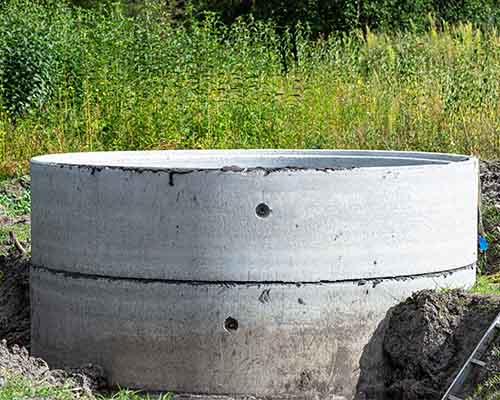Construction of Concrete Water Tanks

Reinforcement and Strength
Concrete water tanks are meticulously constructed with a focus on reinforcing the material to ensure structural integrity and longevity. Reinforcement typically involves strategically placing steel rebars within the concrete walls. These rebars serve to enhance the tensile strength of concrete, preventing cracking and increasing load-bearing capacity. By carefully engineering the placement and density of reinforcement, engineers ensure that the tank can withstand the immense pressure exerted by thousands of gallons of water. This meticulous reinforcement process is crucial in ensuring the tank’s durability over its operational lifespan, providing confidence in its ability to safely store water without compromising structural integrity.
Waterproofing and Sealing
Concrete water tanks are meticulously constructed with a focus on reinforcing the material to ensure structural integrity and longevity. Reinforcement typically involves strategically placing steel rebars within the concrete walls. These rebars serve to enhance the tensile strength of concrete, preventing cracking and increasing load-bearing capacity. By carefully engineering the placement and density of reinforcement, engineers ensure that the tank can withstand the immense pressure exerted by thousands of gallons of water. This meticulous reinforcement process is crucial in ensuring the tank’s durability over its operational lifespan, providing confidence in its ability to safely store water without compromising structural integrity.
Curing and Setting
The curing process is essential after pouring the concrete to achieve optimal strength and durability of the water tank. Curing involves maintaining appropriate moisture and temperature conditions to promote hydration and proper setting of the concrete. This process allows the concrete to develop its full potential strength and resistance to cracking over time. Adequate curing also reduces the risk of shrinkage and ensures uniformity in the concrete structure, enhancing its long-term performance. Engineers carefully monitor the curing process to achieve the desired concrete properties, ensuring that the water tank meets stringent quality standards and can effectively withstand the operational demands of storing water.
Benefits of Concrete Water Tanks
Durability and Longevity
Concrete water tanks are renowned for their exceptional durability and longevity, making them a preferred choice for water storage solutions. The inherent strength of concrete allows these tanks to withstand harsh environmental conditions, including temperature fluctuations and UV exposure, without compromising their structural integrity. With proper maintenance and care, concrete water tanks can last for several decades, providing reliable water storage throughout their service life. Their durability ensures minimal maintenance requirements and long-term cost-effectiveness compared to alternative materials, making them a sustainable choice for residential, commercial, and industrial applications.
Water Quality Preservation
One of the significant advantages of concrete water tanks is their ability to preserve water quality effectively. Concrete is inert and non-reactive, preventing chemical leaching and ensuring that stored water remains clean and safe for consumption. Unlike other materials, concrete does not impart odors or flavors to the water, maintaining its natural taste and purity over time. This makes concrete water tanks suitable for storing potable water in residential homes, agricultural settings, and municipal facilities where water quality standards must be strictly adhered to. The preservation of water quality is essential for maintaining public health and safety, making concrete tanks a trusted choice in water storage infrastructure.
Structural Stability
Concrete’s inherent weight and density contribute to the structural stability of water tanks, reducing the risk of shifting or deformation under the weight of stored water. The robust nature of concrete ensures that the tank maintains its shape and integrity over time, even when subjected to heavy loads or external forces. This structural stability is critical for ensuring the reliability and safety of water storage operations, particularly in industrial settings where large volumes of water are stored. Concrete water tanks provide peace of mind to operators and users alike, knowing that their water supply is securely stored and protected against potential structural failures.
Fire Resistance
Concrete’s excellent fire resistance properties make it a preferred material for water tanks in fire-prone areas or industrial facilities where fire safety regulations are stringent. Concrete can withstand high temperatures without compromising its structural integrity, providing valuable time for fire suppression efforts and reducing the risk of catastrophic tank failure during fire incidents. This fire resistance feature enhances the overall safety and reliability of concrete water tanks, making them a reliable choice for storing emergency firefighting water reserves or supporting fire suppression systems in buildings and industrial complexes.
Maintenance of Concrete Water Tanks
Inspection and Monitoring
Regular inspection and monitoring are essential to detect any signs of deterioration or damage in concrete water tanks. Visual inspections, leak testing, and structural assessments should be conducted periodically by qualified professionals to identify potential issues early. These inspections help ensure that any cracks, leaks, or structural weaknesses are promptly addressed through appropriate repair and maintenance measures. Monitoring the condition of the tank allows operators to proactively manage its upkeep and extend its service life, minimizing the risk of unexpected failures and ensuring continuous water supply reliability.
Cleaning and Disinfection
Proper cleaning and disinfection of concrete water tanks are critical to maintaining water quality and preventing bacterial contamination. Routine cleaning removes sedimentation, algae buildup, and other contaminants that can affect water taste and safety. Disinfection procedures involve using approved chemicals or treatments to eliminate harmful bacteria and pathogens, ensuring that stored water meets regulatory standards for potable water. Regular cleaning and disinfection practices are essential in residential, commercial, and municipal applications where water quality is paramount, promoting public health and safety through clean and safe drinking water supplies.
Repairs and Rehabilitation
When issues such as cracks, leaks, or structural defects are identified during inspections, prompt repairs are necessary to prevent further damage and restore the tank’s integrity. Repair methods may include patching, sealing, or applying protective coatings to affected areas. Structural rehabilitation projects may involve reinforcing or refurbishing the tank to enhance its structural strength and durability. By addressing maintenance issues proactively, operators can mitigate potential risks and extend the operational lifespan of concrete water tanks, ensuring continued reliability and performance in water storage applications.


